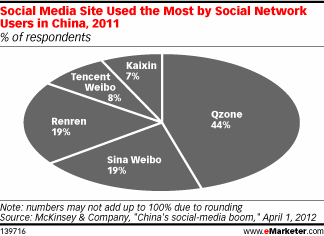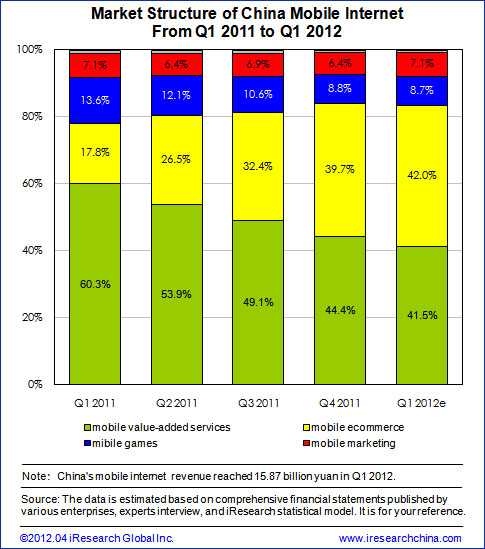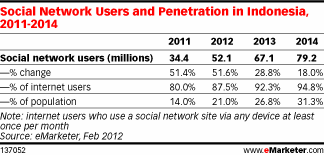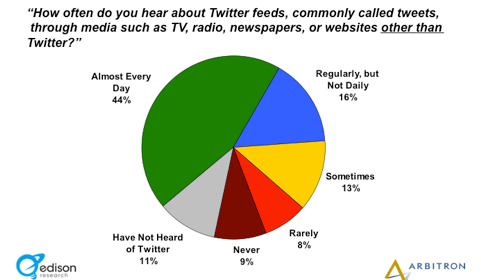We Are Social Asia Midweek Mashup #27
Tencent’s Qzone is reigning social media platform in China
According to a recent report by McKinsey & Company, Tencent’s social networking site Qzone was the most popular social media site among Internet users surveyed in China, with 44% of respondents using the social network. Similarly, data tracked within social sharing platform JiaThis showed that Tencent’s Qzone accounted for 12.95% of social shares in March, while microblogging service Sina Weibo accounted for 8.35% and rival social networking site Renren 3.95% of social shares. Other sources reveal that the Qzone service has 552 million active users, more so than Sina Weibo’s 300 million registered users and Renren’s 147 million activated accounts. Although Qzone may be one of the most actively used social media platforms in China, Sina Weibo still appears to be the platform of choice for marketers to engage and interact with local fans because of the availability and customisability of corporate accounts similar to brand pages on Twitter, even though this might not be so in the future given the speed of change in China’s social media landscape.
Sina Weibo’s new social ads
Sina Weibo has added social ads to its current offerings of brand ads and search ads, which will harness data from the demographic profiles of its users for more accurate ad targeting. There are two types of ads available, namely banner ads that will be displayed either at the top or bottom of the newsfeed on users’ profile pages, or promotion ads of topics, events, videos or products. Reports on ad performance will also be made available, and advertisers will be able to access information on the reach, click-through rate (CTR), engagement, earned reach and engagement, as well as quality and growth of a brand’s weibo followers through its social ads. According to Sina, nearly 100 companies have purchased social ads thus far, but the take-up rate will likely increase once brands catch wind of this new ad feature.
Sina Weibo tightens control over its users
Since admitting its failure to fully implement the real-name registration mandate for microblogs in China, Sina will introduce a new ‘user contract‘ to Sina Weibo users on May 28 that clearly seeks to further control and censor users’ posts. This initiative will see the creation of a ‘community committee’ or a neighbourhood watch of sorts involving members of the public as well as regular members recruited from Sina Weibo’s user base, who will seek to implement the terms of service. The terms have been translated by netizens and can be found here.
As Jon Russell from The Next Web points out, the terms under Article 13 are of particular concern as they point out the wide range of content that users must refrain from posting, subjected to the community committee’s discretion.
Article 13) Users have the right to publish information, but may not publish any information that:
1. Opposes the basic principles established by the constitution
2. Harms the unity, sovereignty, or territorial integrity of the nation
3. Reveals national secrets, endangers national security, or threatens the the honor or interests of the nation
4. Incites ethnic hatred or ethnic discrimination, undermines ethnic unity, or harms ethnic traditions and customs
5. Promotes evil teachings and superstitions
6. Spreads rumors, disrupts social order, and destroys societal stability
7. Promotes illicit activity, gambling, violence, or calls for the committing of crimes
8. Calls for disruption of social order through illegal gatherings, formation of organizations, protests, demonstrations, mass gatherings and assemblies
9. Has other content which is forbidden by laws, administrative regulations and national regulations.
Users who fail to comply will subsequently be subject to the following consequences.
Article 23) Processing of regulation violations includes: the processing of content and accounts.
Content processing includes: deletion, preventing reposting, disabling commenting or annotation, etc.
Account processing includes: preventing posting of weibos, forbidding following, and deletion of the account.
It remains to be seen how much different the user behaviour and content on Sina Weibo will be after these terms are implemented on May 28.
China’s mobile Internet revenue
China’s mobile Internet revenue totalled 15.87 billion yuan or S$3.13 billion in the first quarter of 2012, an increase of 167.2% from the same period last year. Mobile e-commerce contributed the largest share of 42% to the revenue, followed by mobile value-added services which include video, music, and e-reading at 41.5%, mobile games at 8.7% and mobile marketing at 7.1%. We can clearly see the emphasis on mobile marketing given the increase in number of mobile users as well as the increased sophistication in which mobile users utilise their devices, which is reflected in the increase in revenue for mobile marketing even as all other sectors see a fall from Q1 2011 to 2012.
Internet and social media penetration in Indonesia
eMarketer predicts that the number of Internet users in Indonesia will grow by 38.6% to reach 59.6 million this year, accounting for nearly a quarter of Indonesia’s total population. Similarly, the number of social network users in Indonesia is expected to continue growing by 51.6% in Indonesia to 52.1 million social network users in 2012. Currently, Indonesia has 42.27 million users on Facebook. This would rank Indonesia as the second-fastest-growing country of social network users in the world, narrowly beat out by India, which had surpassed its number of Facebook users earlier this year.
Growth of online video advertising
Emarketer predicts that the online video advertising market will grow more than 40% annually for the next three years before levelling off at a growth rate of 20%. Even so, half of this US$1.8 billion pie is divided between the two major players – Hulu and YouTube. According to comScore, Hulu recorded 1.75 billion video-ad impressions in March, which indicates a 39% year-on-year increase. Marketers are increasingly re-allocating their TV spend into online video advertising, especially since sites like YouTube have an international reach and therefore a wider audience beyond US shores. We’ll likely see this trend carry forward into the future as marketers reallocate ad spending amongst a broader mix of mediums.
Participation inequality: 1/9/90 rule no longer applies?
After carrying out an in-depth investigation into how the UK online population uses digital media, the BBC has developed a new model of digital participation: The Participation Choice. Going against accepted models, specifically the 1/9/90 rule, it suggests that participation is now the norm, claiming that 77% of the online population in the UK is now active ‘in some way’. For those wanting to know more (as well as those who remain unconvinced), a presentation on the research should be available later this week on the BBC Internet blog.
The impact of Twitter (it’s bigger than you think)
Some research from Edison suggests that Twitter is managing to reach beyond the one in ten Americans who actively use the service. The research reveals that more than four or ten Americans hear or read about tweets almost everyday in the media. With numbers that large, the importance of Twitter as a broadcast network is evident, both for brands seeking to get their message out there as well as those seeking to combat any potential social media crises.
Poor social media customer service? You just lost a sale!
A new report from American Express exploring consumer attitudes and preferences towards consumer services confirms the value of social media as a customer service tool. It found that of those who use social media to make customer service queries, 83% had chosen not to make a purchase because of a poor customer service experience. The report also found that while consumers who use social media for customer service are the most vocal in both their praise and criticism, like their offline counterparts they are much more likely to share a negative experience, telling an average of 53 other people about it.
Facebook popular with mobile users
While most already expect that mobile will play an important part in Facebook’s future fortunes, research from comScore underscores how important it is in Facebook’s present: in March, US mobile visitors spent an average of 7.35 hours on their mobile site and/or app, putting Facebook way ahead of Twitter and Foursquare.
| Social Networking Properties (Mobile Browser and App Audience Combined March 2012 Total U.S. Smartphone Subscribers Age 18+ on iOS, Android and RIM |
|||
| Total Unique Visitors (000) | % Reach | Average Minutes per Visitor | |
| 78,002 | 80.4% | 441.3 | |
| 25,593 | 26.4% | 114.4 | |
| 7,624 | 7.9% | 12.9 | |
| 7,493 | 7.7% | 52.9 | |
| Foursquare | 5,495 | 5.7% | 145.6 |
| Tumblr | 4,454 | 4.6% | 68.4 |
Global social media report reveals top industries on Facebook
Socialbakers has published a report on the top 10 performing industries on Facebook and brands within each. Auto and alcohol brands came out on top for both engagement and fan growth.
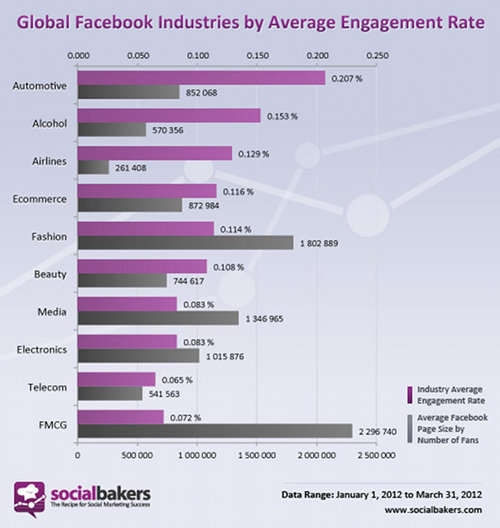
Facebook finally sets a date for its IPO
Facebook shares will float on the US stock market on Friday the 18th of May, according to sources in Silicon Valley, following a Zuckerberg-helmed roadshow that kicked off yesterday in New York. It had been expected that the founder would not attend the roadshow, instead being led by COO Sheryl Sandberg and CFO David Ebersman, but he did and initial reports suggest he came across as ‘likeable and affable’.
Another milestone for Facebook’s Instagram: 50 million users
CNet claims that Intstagram has now reached 50 million users and is adding 5 million users per week.
Facebook adds Instagam-lite functionality for feature phones
Facebook hasn’t forgotten about those of you without a smartphone, updating their Facebook for Every Phone app to provide simple photo filter options so everyone can join in the vintage-feel-fun.
Facebook makes another mobile acquisition: Glancee
In what’s arguably a blow for Foursquare, and definitely one for direct competitor and SXSW darling Highlight, Facebook has acquired location app Glancee. While Facebook has been typically quiet on its plans for the app, it fits in well with the company’s location strategy of going beyond simple check-ins toward allowing users to share their past, present and future locations.
Facebook releases mobile app data
The Facebook developer blog last week revealed the traffic it drives to mobile apps, sending 160 million visitors to mobile apps just last month (an increase of 100 million since late February). The impact of integrating Facebook functionality is revealed further by looking at the top grossing apps for mobile – 7 of the top 10 iOS and 6 of the top 10 Android apps are integrated with the platform. Facebook suggests that features like Single Sign On and Open Graph have been responsible for the phenomenal growth of apps such as iOS video sharing app Viddy, which now has more than 16 million users.
Open Graph is ‘steroids for start-ups’. Or is it?
More evidence of the impact of Facebook’s Open Graph, with the latest study looking at how Facebook helped accelerate growth for apps such as Pinterest, Viddy and Socialcam. Inside Facebook has also delved further into Viddy and Socialcam’s techniques, which seem to be pretty successful.
The risks associated with this kind of super-speed growth, and dependence on the Facebook platform, are becoming evident too, with Pinterest’s recent sharp drop in active users being put down to Facebook disabling the auto-publish function and today’s furore over the Washington Post’s and the Guardian’s decline in traffic from their social reader apps, which Martin Belam has expertly dissected.
Facebook’s new ‘action links’
Also of interest to brands, Facebook has reintroduced ‘action links’, the customisable links which provide a way for users to engage with apps more easily, increasing the viral potential of each story. Foursquare is one of the first to take advantage of the new functionality, adding a “save this place” link to check-in stories. Clicking on an action link will share a story on users Timelines. Previously, users could Like or comment on an activity or click to visit the app, but there weren’t app-specific calls to action that functioned this way.
The social (engineering) network?
Facebook’s desire to get users to share their organ donor status has come under the spotlight this week. Although some are clearly happy to sign-up (by the end of its first day 100,000 users had registered), it does raise questions over Mark Zuckerberg’s vision for Facebook and if it will continue as a platform that connects individuals or becomes one that seeks to influence them.
Twitter personalises discovering stories
Twitter will roll out a redesign with increased personalisation of the Discover tab in the coming weeks. It will use additional signals, such as tweets that are popular amongst people you follow, to select stories to display. The new design will also show who tweeted about particular stories, adding a social context to them.
Google+ Hangouts On Air now available to users worldwide
Originally only available to selected broadcasters, Google+ has now made its Hangouts On Air feature available to all users. If you have something to say to the world you will be able to broadcast live publicly from Google+, YouTube or a website, see viewing figures, and record and share your broadcast.
Pinterest drives more sales than Facebook
On the other hand, Pinterest’s reputation as a driver of sales continues to grow. According to jewelry retailer Bottica, Pinterest drives 10% of its sales compared to 7% from Facebook. More importantly, those customers spend twice that of Facebook users. It goes to show that people perhaps really do use Pinterest to discover new products.
Foursquare partners with OpenTable to offer dinner reservations
Foursquare have launched a function to actually make a dinner reservation through their app using OpenTable. OpenTable, an online reservations service is currently available in over 15,000 places across the US, handy for users and another incentive for restaurant owners to maintain their Foursquare presence.
LinkedIn claims B2B top spot
Research from HubSpot indicates that LinkedIn is the place to be for B2B conversions. In 2011, LinkedIn generated a visitor-to-lead conversion rate of 2.60%, on average four times higher than Twitter (0.67%) and seven times higher than Facebook (0.39%). It’s also growing faster than these two rivals but recently fell behind in monthly user activity.
Man City vs Man Utd scores a million tweets
The popularity of sporting events on Twitter continues: after the record-breaking tweet total generated by the Barcelona-Chelsea game, data from Sysomos suggests that the Manchester City vs Manchester United football match received over 1 million mentions on Twitter.
Budweiser run Zeebox dual-screen campaign for FA Cup Final
In more football news, Budweiser ran a dual-screen campaign together with Zeebox to allow users to interact with Saturday’s FA Cup Final. Most interestingly, viewers could also play a Be The Ref social game within the app, which let them enact the part of the referee or dispute decisions, and share their decisions with other friends via the app’s Facebook integration.
Nutella goes nuts over Facebook
Nutella claims that it’s Facebook ads outperformed TV in a recent campaign. Ferrero attributed 15% of sales from their Christmas campaign to Facebook, and it was also the channel that gave the highest return on investment. It’s fair to say that social media helped them spread their story.
Der Big Mäc: McDonalds Germany crowdsources burger
In celebration of it’s 40th anniversary in Germany, McDonalds will create its first crowdsourced burger. As part of the ‘Mein Burger’ campaign, fans were asked to create their own burger using an online burger-builder, name it and put it to the public’s vote. After 5 million votes were cast on over 100,000 burgers, the winner emerged as the ‘Pretzelnator’. According to McDonalds (and somewhat implausibly, considering the number of votes), 1 in 4 Germans took part in the campaign:
Baskin Robbins launches Foursquare promotion for Men In Black 3
Despite the first Men In Black movie being released over 10 years ago, marketers are hoping to cash in on the franchise’s success a third time around. One of the more interesting promotions comes in the form of a Foursquare check-in competition from Baskin Robbins, which is supported by a mobile site where consumers can register and also add Facebook check-ins or share their entries. Check-ins on either platform enter the user into a sweepstakes as well as earn them achievement badges they can share across Facebook and Twitter.
National Trust: a great British day out
The National Trust are launching a campaign that asks Facebook users to design a ‘Great British Day Out’. Aimed at targeting a younger audience, the Facebook app allows users to select a National Trust destination, choose a theme for their trip and invite friends. Facebook users can vote for the top 20 days out with the winner eventually being decided by the National Trust.
Republicans expand social media efforts with ‘Social Victory Centre’
The Republican National Committee digital team has created the ‘Social Victory Centre’ app, the first of its kind in the political sector. Working on the principle that politics is inherently social, they hope that the app will amplify natural sharing activities such as recommending articles. The app also features a ‘phone from home’ ability that allows those in non-contentious states to make calls on behalf of the RNC to attempt to persuade voters in battleground states.
